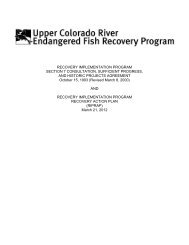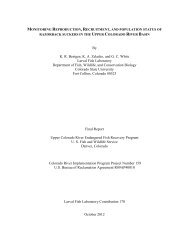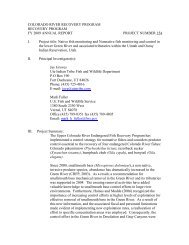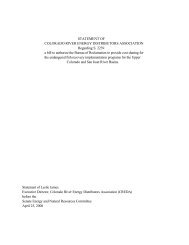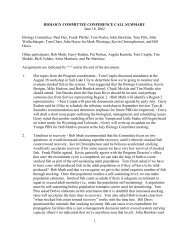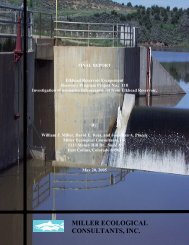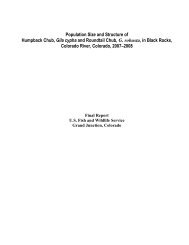The explanation <strong>for</strong> low razorback sucker reproduction was that, currently, flows <strong>of</strong>ten do notreach levels high enough to inundate low-lying floodplain features where spawning takes place.The Service also reported that in the absence <strong>of</strong> high spring flows, important backwater habitatsfilled with silt and sand, tamarisk colonized sand and cobble bars, and nonnative minnows capable<strong>of</strong> preying on or competing with larval endangered fishes greatly increased in numbers.The Service's earlier flow recommendations <strong>for</strong> spring identified the magnitude and frequency <strong>of</strong> arange <strong>of</strong> minimum peak flows and the mean monthly flows capable <strong>of</strong> producing these peaks and<strong>of</strong> maintaining the natural shape <strong>of</strong> the hydrograph. Refinement <strong>of</strong> these earlier flowrecommendations <strong>for</strong> spring was based on the results <strong>of</strong> new streambed monitoring studies. Theresults <strong>of</strong> one study showed that the spring run<strong>of</strong>f in 1993, which peaked at 25,900 cfs, wascapable <strong>of</strong> moving coarse bed materials thereby winnowing accumulated fines from the channelsubstrate. Based on preliminary results from hydrologic modeling (Pitlick and Van Steeter 1994),Osmundson et al. (1995) assumed that the earlier recommended peak <strong>of</strong> 23,500 cfs would also becapable <strong>of</strong> moving bed materials. The results <strong>of</strong> another study (Pitlick et al.1996) showed that aspring run<strong>of</strong>f with a peak <strong>of</strong> about 12,900 was capable <strong>of</strong> flushing accumulated fine sedimentsfrom the bottoms <strong>of</strong> backwaters thereby restoring their depth. Based on this in<strong>for</strong>mation, theService refined the earlier recommendations <strong>for</strong> spring peak day flows as follows:Target Peak Day Spring Flows in the 15-Mile Reach:>23,500 cfs (5 in 20 years)21,750 cfs (10 in 20 years)16,700 cfs (16 in 20 years)12,900 cfs (20 in 20 years)The Service's 1995 year-round flow recommendations are summarized in Table 2 as meanmonthly discharges. Spring (April-July) recommendations are further subdivided into 10-dayincrements and are reported in Table 3 as volumes <strong>of</strong> water needed <strong>for</strong> each <strong>of</strong> twelve 10-daytime periods. The mainstem Colorado River above the 15-Mile Reach does not have a largereservoir that controls flows. There<strong>for</strong>e, variation in precipitation levels from year to year istaken into account and recommendations are provided <strong>for</strong> years <strong>of</strong> high, above-average,below-average, and low snow fall. With the exception <strong>of</strong> winter, recommendations are <strong>for</strong> flowsconsiderably lower than historic levels (1902-1942) but somewhat higher than recent levels.ENVIRONMENTAL BASELINERegulations provide that the environmental baseline includes the past and present impacts <strong>of</strong> allFederal, State, and private actions and other human activities in the action area; the anticipatedimpacts <strong>of</strong> all proposed Federal projects in the action area that have already undergone <strong>for</strong>malsection 7 consultation; and the impact <strong>of</strong> State or private actions contemporaneous with theconsultation process. Environmental baselines do not include the effects <strong>of</strong> the Federal actionunder review in the consultation.39
Applying the above regulations, the environmental baseline <strong>for</strong> this project includes the past andpresent effects <strong>of</strong> Reclamation operations, Federal and non-Federal depletions as well as the pastand present actions <strong>of</strong> funding and implementing the Recovery Plan, but does not include thefuture effects <strong>of</strong> the Federal action previously described on page 1. This baseline is used toevaluate the future effects <strong>of</strong> the Federal action. The environmental baseline <strong>for</strong> this consultationis not typical, because <strong>for</strong> the purposes <strong>of</strong> this analysis, all <strong>of</strong> the subject existing water depletionsincluding those treated as interrelated, are part <strong>of</strong> the action. Typically, only impacts from actionswith no Federal discretionary authority would be included in the baseline; however, because <strong>of</strong> thelarge scope <strong>of</strong> this programmatic biological opinion, it was not possible to determine the extent <strong>of</strong>existing or future Federal discretion <strong>for</strong> all existing and new Federal actions covered by thisopinion. Also, it is likely that most water depletion projects have or will have a Federal actionassociated with them and would rely on the Recovery Program to avoid the likelihood <strong>of</strong> jeopardyand adverse modification <strong>of</strong> critical habitat. Because the environmental baseline does not includethe project being consulted on, and all water depletions are part <strong>of</strong> the project being consulted onas described in the Federal action on page 1, the environmental baseline conditions, solely <strong>for</strong> thepurpose <strong>of</strong> this analysis, represent the river with the impacts <strong>of</strong> human depletion actions taken outand shall be referred to in this biological opinion as “baseline flow conditions.” Other impactssuch as nonnative fish, dams, fish barriers, and bank stabilization are assumed to be in place underbaseline conditions. The only purpose <strong>of</strong> using the “baseline flow conditions” is <strong>for</strong> comparisonwith existing depletions. This baseline is not appropriate <strong>for</strong> individual section 7 consultations,nor does it confer any obligation on the Federal action agencies to restore the river to a conditionsimilar to that existing prior to human depletion actions. Baseline flow conditions were modeledas described below.Table 2. Recommended mean monthly flows <strong>for</strong> the top <strong>of</strong> the 15-Mile Reach in cubic feet persecond. Rate is the percent <strong>of</strong> years recommended <strong>for</strong> identified flows based on winter snowpacklevels. For example, in the wettest 25 percent <strong>of</strong> years, flows in June should average at least15,660 cfs; stated another way, this recommendation should be met in 5 <strong>of</strong> every 20 years.During low-water years, June flows should average no less than 6,850 cfs, and such a minimumshould occur at a rate <strong>of</strong> no more than 4 in 20 years (20 percent). Table from Osmundson et al.1995.40Rate 25 percent 25 percent 30 percent 20 percentExceedance 25 percent 50 percent 80 percent 100 percentJAN 1,630 1,630 1,630 1,240FEB 1,630 1,630 1,630 1,240MAR 1,630 1,630 1,630 1,240APR 3,210 2,440 2,260 1,860MAY 10,720 9,380 7,710 7,260
- Page 1 and 2: FINAL PROGRAMMATIC BIOLOGICAL OPINI
- Page 3 and 4: INCIDENTAL TAKE ...................
- Page 5 and 6: 2" Reclamation’s portion of 120,0
- Page 7 and 8: On January 21-22, 1988, the Secreta
- Page 9 and 10: funding component of the Recovery P
- Page 11 and 12: 81. Habitat Protection ElementGener
- Page 13 and 14: Also, the Service and the Colorado
- Page 15 and 16: Table 1. The estimated benefits in
- Page 17 and 18: through recovery efforts that will
- Page 19 and 20: native fishes. Also, some species o
- Page 21 and 22: “new” depletions. This would in
- Page 23 and 24: Based on early fish collection reco
- Page 25 and 26: infrequent pulsed recruitment make
- Page 27 and 28: Area, in the Loma to Black Rocks re
- Page 29 and 30: 26Figure 1. Distribution of adult C
- Page 31 and 32: during high flows. Some of the pike
- Page 33 and 34: In the Upper Basin, above Glen Cany
- Page 35 and 36: 32Populations DynamicsThere are no
- Page 37 and 38: in low velocity shorelines and back
- Page 39 and 40: 36IMPORTANCE OF THE 15-MILE REACHTh
- Page 41: occur in the 15-Mile Reach). Provid
- Page 45 and 46: in a river basin. While the model i
- Page 47 and 48: 44Factors Affecting Species Environ
- Page 49 and 50: 46To determine conditions with wate
- Page 51 and 52: 48140001200010000CFS800060004000200
- Page 53 and 54: 50CFS240002200020000180001600014000
- Page 55 and 56: 52CFS280002600024000220002000018000
- Page 57 and 58: Release and protection of surplus H
- Page 59 and 60: 56CFS500045004000350030002500200015
- Page 61 and 62: The formation of a variety of chann
- Page 63 and 64: options will be determined through
- Page 65 and 66: Passage at the Price-Stubb Diversio
- Page 67 and 68: species. Recent population estimate
- Page 69 and 70: the endangered fishes. Ongoing Reco
- Page 71 and 72: 68the Colorado pikeminnow, razorbac
- Page 73 and 74: 70There are no current population e
- Page 75 and 76: additional reasonable and prudent m
- Page 77 and 78: The Recovery Action Plan is an adap
- Page 79 and 80: 76actions have all been completed a
- Page 81 and 82: 78LITERATURE CITEDAbbott, C. C. 186
- Page 83 and 84: 80the Upper Colorado River Basin, P
- Page 85 and 86: Kaeding, L. R., and D. B. Osmundson
- Page 87 and 88: Minckley, W. L. 1983. Status of the
- Page 89 and 90: Pitlick, J., and M. Van Steeter. 19
- Page 91 and 92: Tyus, H. M., B. D. Burdick, R. A. V
- Page 93:
Wick, E. J. 1997. Physical processe



